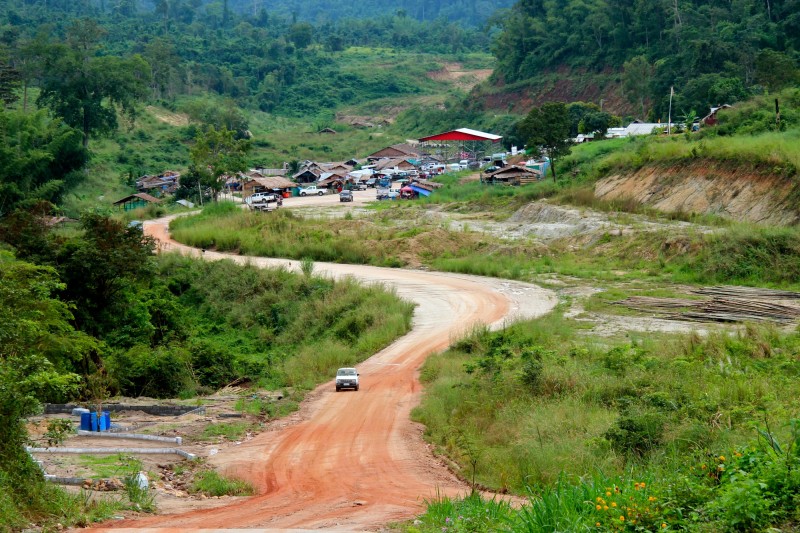
The trick to having an adventure of your lifetime doesn’t require you to purchase expensive flight tickets to obscure places nor to put yourself into dangerous situations where only luck could get you out off. It definitely doesn’t require you to be bold or fearless though a little bit of open-mindedness would go far.
If you want an adventure that gives you bragging rights, why not change the way you travel? Instead of flying directly to your destination, try taking trains or busses instead. If you can throw in more interesting options like hitch-hiking, motorbiking and cycling, then the possibilities of turning an ordinary journey into an extraordinary one, are tremendous. All you need is a bit of time in your hands.
I’ve had always wanted to return to Myanmar since my last visit in 2006. Then, I’d acted on an impulse – found an incredible opportunity to spend 7 weeks volunteering in a makeshift village school in Thaketa, just a little out of Yangon, and had the most amazing time ever. Seven weeks wasn’t enough. I was utterly smitten by the generosity of the locals and the way they’ve led their lives with integrity in a country that was then, so closed off to the rest of the world. I’d vowed to return.
Now, almost a decade later, I found myself pondering at the prospects of going back. But flying directly into the gleaming new Yangon International Airport seemed too easy for someone who has a penchant for the untrodden.
A quick search on the Internet helped me discover that only very recently, four border crossings between Thailand and Myanmar had opened up. This allows travellers the rare opportunity to travel overland between the two countries for the first time in more than 50 years. The borders, which were previously used for visa runs, now allow onward travel all the way into central Myanmar without restrictions. My heart leapt with glee: this could be it!
A rough plan was quickly drawn up and it included a mish-mash of land transportation from Singapore to Myanmar via Malaysia and Thailand with a number of pit stops in between.
My partner thought I was crazy but even he could not say no to a potential adventure.
LEG #1 – Singapore to Penang
Perhaps it would have been easier to fly this leg of the trip but with plenty of time on our hands and a tight budget, we opted to take a coach instead. This way, we had not only saved a night’s stay somewhere but also got into Georgetown directly without needing to fork out extra cab costs from the airport. Starmart Coach took us from the steps of Golden Mile Tower on Beach Road to Sungai Nibong Express Bus Terminal in the outskirts of Penang island. Our ride departed at 10.00 P.M. and entered the border of Malaysia via Tuas (Second Link). Traffic was smooth and the immigration counters less congested in comparison to Woodlands’ (First Link). For SGD 45 each, we had a good night’s rest on the coach’s plush seats that came with plenty of legroom. At about 7.00 A.M., the arrival at the bustling Sungai Nibong Express Bus Terminal woke us up.
Penang serves as a perfect pit stop to our overland odyssey. We kept ourselves busy with the city’s colourful cultural sights, stuffed ourselves like mad and traversed across the island with a rented motorbike. Streets and alleys were brimming with street food stalls spilling over that it was hard not to get caught up in the feeding frenzy.
LEG #2 – Penang to Bangkok
The whole idea about backpacking or travelling without a certain timeline or thorough planning is to improvise when necessary. Our initial idea here was to take a slow 24-hour train ride from Butterworth to Bangkok but our trip had coincided with the Hari Raya holidays. Tickets were sold out for the next few days at least. We were left with two options: stay stuck or find other means of transportation. Direct flights from Penang were too expensive while a combination of a few shared mini-vans would have us tuck our knees in a confined, frigid space for more than 15 hours.
The only way out of this was to cheat a little. To get out of the rut, we took a 4-hour mini van to Had Yai. From there, we found a cheap songthaew (40 Baht each) to Had Yai’s International Airport and then flew to Bangkok for 1360 Baht.
We changed plans at the eleventh hour but nonetheless, found ourselves back on track without extra expenses. The energy of Thailand’s capital jolted our senses awake when we touched down. With an extra night in Bangkok, we hailed a bus into the pulsating city with our backpacks in tow.
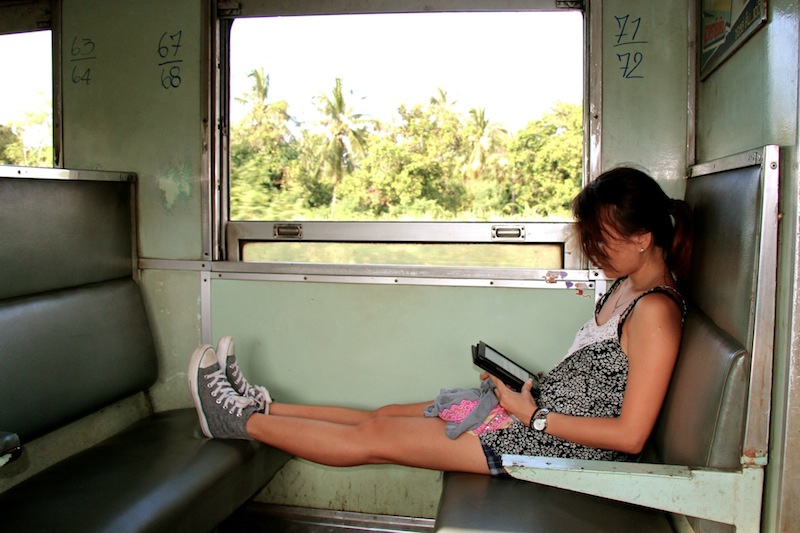
LEG #3 – Bangkok to Kanchanaburi
Bangkok wore us out. The muggy air, the scorching sun, the endless shopping and teeming crowds in just about every nook took a toll on us. After a few frenetic days and a 28-day Myanmar tourist visa slickly stuck on our passports, we knew it was time to leave. Then, it got a bit tricky.
If there was a time where we felt like we were in an episode of Amazing Race, it was at that very moment when we were searching for the right Thornburi Railroad Station where all trains to Kanchanaburi would depart from. Google Maps had specifically directed us to one but what we didn’t know was that there was more than one. As luck would have it, our taxi driver dropped us at the wrong one, the older one. Oh–our aghast when the lady at the ticketing counter turned us away and told us to go the newer station. It will depart in 30 minutes, she had warned, so we’d better hurry. Her warning made us zip through the dallying throngs. At the main road, we quickly jumped into a taxi where the driver grinned constantly and spoke almost no English.
When we arrived, we had only about 5 minutes left to grab the tickets (100 Baht each), buy papaya salad for the ride and find our seats. Just when we were arranging our backpacks in the luggage compartment above our heads, the whistle blew, the station bell clanged and the wheels started to turn.
Just 130 km from Bangkok, Kanchanaburi is a provincial town that tourists frequent to better understand the nation’s darker past. WWII memorials and museums tell of how the Japanese forces used Allied prisoners of war to build a long rail route to Myanmar. The Bridge over the River Kwai is also one of the town’s main attractions, and also not surprisingly, where most of guesthouses and hotels are found. With a bicycle or a motorbike, you can easily cover the sights and also get to the daily night market by the railway station. Here, you can truly feast and shop for almost nothing!
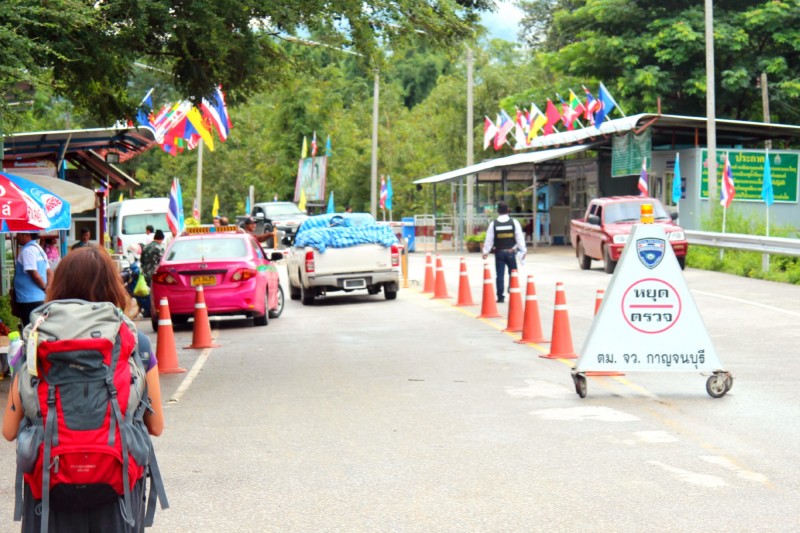
LEG #4 – Kanchanaburi to Phu Nam Ron/Htee Khee border
If you ask around at the Kanchanaburi bus station, locals will tell you to take that blue bus to the frontier of Thailand. You can pay on the bus, 70 Baht per person. The first bus leaves at 10.30 A.M. and then every hour after that. Since we didn’t quite know what lied beyond the Thai borders, we decided to take the earliest bus.
When the Thai Immigration Officer stamped me out, my traveller instincts buzzed with anticipation. In front of us was a long stretch of No Man’s Land. Whatever that was about to happen would be new and uncertain. We had never ventured on this path before.
There were no other backpackers or tourists in sight. Locals from both sides only looked at us bemused. No signs of public transportation that could ferry us across. We were left with only one option: hitch-hiking.
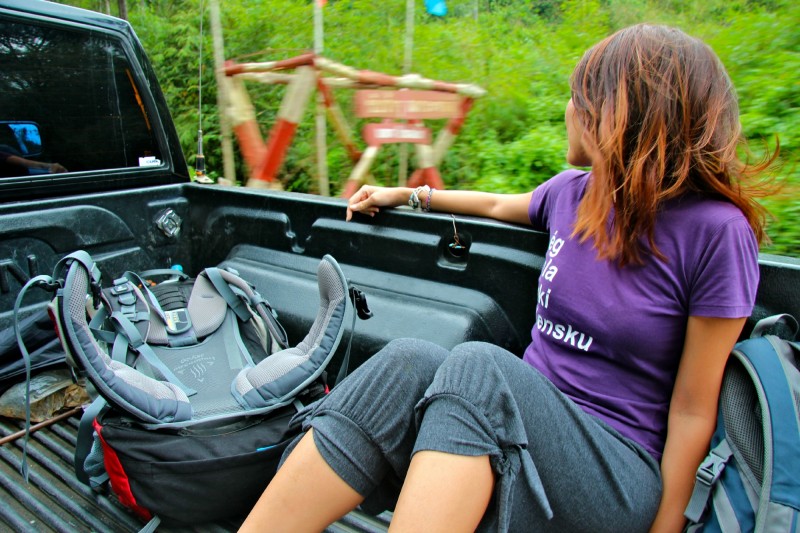
LEG #5 – Phu Nam Ron border (Thailand) to Htee Khee (Myanmar)
Pragmatism trumps fear in situations like this. When we actively sought out for potential drivers, the idea that speaking to strangers could land us in a hot soup didn’t even cross our minds. There was a black pick-up truck parked on the side of the road, not too far from the Thai border outpost. The engine was still running and the driver was behind the wheel, as though he was waiting for someone.
His red stained teeth revealed that he was Burmese. Without speaking a word of English, he smiled when I asked for a ride. We took that as a ‘yes’ and climbed into the back of the pick-up. Eventually, when his companion joined him, we took off through the 7-8 km of paved roads, flanked by dense jungles.
We had to go through another checkpoint before arriving at the chaotic tiny Htee Khee point. It was a gathering point of sorts that consisted of a shop, a petrol station and a transport terminus. Thai and Burmese people were congregating, taking cigarette breaks and stretching their legs. Many were eating and drinking at the tea shop adjacent to the transport terminus.
Weirdly, despite being at Htee Khee, the Myanmar Immigration Office was still further downhill, at least another kilometer away.
Confusion set in when there was no straightforward way to find out how we could proceed next.
We had enquired for a ride to Dawei, the closest town that offers accommodation to foreigners, but no one could tell us anything straight up. Burmese ladies with bright thanaka powder slathered on their cheeks, merely giggled or looked away shyly.
At some point, after a few false steps, a man approached us and promised that a driver could take us to Dawei for 25 USD per person. He didn’t exactly say how because all he said was, “Dawei. 25 dollars.” There was nothing to do but to trust this man. After we gave him the money, a van and a driver appeared.
5 hours later and a great deal of butt ache (the paved roads didn’t extend beyond Htee Khee), we arrived in Dawei at dusk. As this route didn’t open to foreign travel until recently, we were subjected to tedious passport checking at various points of the journey. The van had bumped up and down mountainous terrain, narrow edges and through many nameless villages. Every now and then, children ran barefooted alongside the van and waved to us.
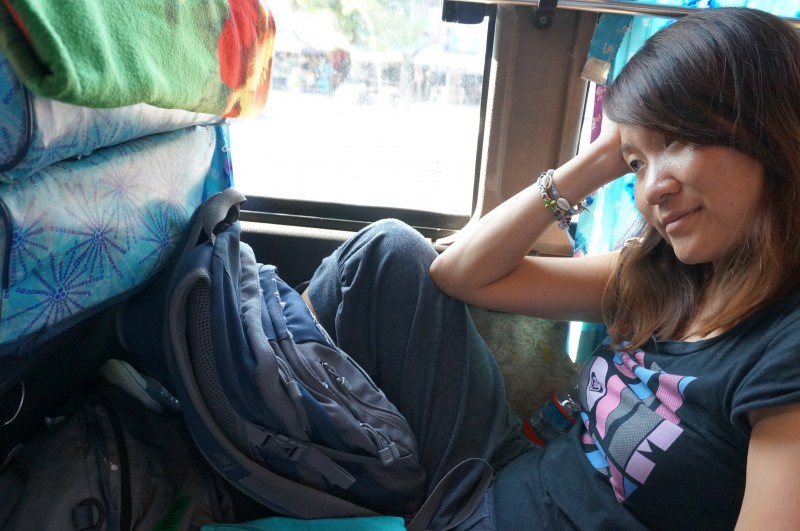
LAST LEG #6 – Dawei to Yangon
The fast-growing tourism in Myanmar hadn’t touched remote Southern towns like Dawei yet. Without many tourists there, adults and the young ones of Dawei regarded us with curiosity and friendliness. We ate in small, dank restaurants and drank sweet tea amongst the locals. A few days spent walking around bustling Dawei allowed us to unwind within an environment that has yet to be designed around foreigners. It felt genuine for a change; we were not seen as walking ATMs.
However, as the town still lacked tourist infrastructure, there were no comfortable coaches to take us to Yangon. Our bus was more than an hour late and yet the manager of our hotel had told us that this was the second best bus company in Dawei (the best was sold out).
The hard, peeling seats were designed for 4-year olds. There was no space to store our luggage. We piled our backpacks on the floor of our seat and put our feet on them. Our knees touched the back of the seats in the front and we thought to ourselves, what we wouldn’t give to have a first class coach like the one that took us from Singapore to Penang.
It had cost us 15 USD each to embark on an excruciating, backbreaking 19-hour bus journey to Yangon. Toilet stops were rare and you would need a torchlight just so that you could see where the large spiders reside and not have them crawling over you.
If you are brave enough, you can do what the local passengers do. Local passengers, including the women, would just roll up their longyis (a sarong-like apparel) and do their business on the side of the road.
—
When the bus would eventually rolled into the Yangon Aung Mingalar Bus Terminal, we wondered dazedly and in sheer exhaustion, why didn’t we just take that darn flight from Singapore or KL to Yangon?
However, while a seemingly complete-waste-of-time odyssey may appear as unnecessary to some, would you, a true adventurer, have skipped this entire ordeal just to get to your destination? Would you have otherwise discovered those nameless villages, the people whose names that you didn’t remember but whose kindness you’d never forget, the diverse landscapes and the endless cycle of sunrises and sunsets?
Remember, it’s the journey, not the destination that counts. Sometimes, only in an arduous journey can you find out what you’re truly made of.

More from Zafigo:
Finding peace on long train journeys
The most important thing to pack as a single female traveller
Get all the latest travel updates from Zafigo. Follow us on Facebook, Twitter, and Instagram.